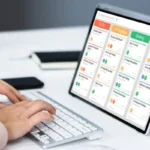Yes, it is crucial to learn project management software. It enhances productivity, organization, and team collaboration.
In today’s fast-paced work environment, managing projects effectively is essential. Project management software offers tools to streamline tasks and improve efficiency. It helps in keeping track of timelines, resources, and budgets. With the right software, you can reduce errors and ensure that projects stay on track.
Learning this software can give you a competitive edge in your career. It is valuable for anyone involved in project planning and execution. Understanding its importance can lead to better project outcomes and increased job satisfaction. So, let’s explore why mastering project management software is vital for success.

Credit: functionpoint.com
Introduction To Project Management Software
Learning project management software is crucial. It helps organize tasks, track progress, and improve team collaboration. Enhancing these skills can lead to more efficient project completion.
Learning project management software is vital for professionals today. These tools help teams organize, plan, and execute projects efficiently. With the right software, managing tasks becomes simpler. Deadlines are easier to meet. Communication among team members improves.
The Evolution Of Project Management
Project management has come a long way. In the past, people used pen and paper. Then came spreadsheets. These methods were basic and often led to errors. In the late 20th century, digital tools began to emerge. These tools offered new ways to track tasks and deadlines. They made project management more efficient.
Modern Software Solutions
Modern project management software offers many features. These tools integrate with other software. They offer real-time collaboration. They provide dashboards for easy tracking. Users can set priorities and allocate resources. Modern software helps teams stay on the same page. It reduces miscommunication and improves efficiency.

Credit: in.pinterest.com
Enhanced Team Collaboration
Learning project management software can greatly enhance team collaboration. It helps teams work together more efficiently. The software provides tools and features that enable better communication and information sharing. This leads to improved project outcomes and a more cohesive team environment.
Real-time Communication
Project management software offers real-time communication features. Team members can quickly share updates and ask questions. They can also provide feedback instantly. This reduces delays and misunderstandings. Everyone stays on the same page throughout the project.
Centralized Information
With project management software, all project information is in one place. This includes documents, task lists, and schedules. Team members can access this information anytime. There is no need to search through emails or different systems. This saves time and reduces confusion.
Centralized information also ensures that everyone has the latest updates. If there are changes to the project, everyone knows right away. This leads to better decision-making and a smoother workflow.
Improved Time Management
Learning project management software is essential for improved time management. This software provides tools and features to organize tasks efficiently. It helps in planning and managing time better. Let’s explore how it enhances time management.
Task Scheduling
Task scheduling is crucial in project management. Project management software allows you to create a clear schedule. It helps in assigning tasks to team members. You can set priorities and deadlines for each task. This ensures everyone knows their responsibilities.
With task scheduling, you can see the bigger picture. It helps in avoiding overlapping tasks. You can manage resources effectively. This leads to better time management and productivity.
Deadline Tracking
Meeting deadlines is vital for project success. Project management software helps in tracking deadlines easily. It sends reminders for upcoming deadlines. This keeps the team on track and focused.
Deadline tracking also helps in identifying potential delays. You can take corrective actions in time. It ensures that projects are completed on schedule. This reduces stress and improves efficiency.
Resource Allocation
Resource allocation is a key aspect of project management. It involves the distribution of resources such as time, money, and manpower to achieve project goals. Effective resource allocation ensures that projects run smoothly and efficiently.
Optimizing Resources
Optimizing resources is about using what you have wisely. Project management software helps in tracking all resources. It shows how much time team members spend on tasks. It also tracks budget and materials.
The software provides real-time updates. This allows managers to adjust plans quickly. They can see if tasks are on schedule. They can also identify any delays.
Let’s look at some ways to optimize resources:
- Assign tasks based on team members’ skills
- Track progress and adjust deadlines
- Monitor budget and spending
- Identify bottlenecks and address them
Using project management software makes these steps easier. It ensures that resources are used efficiently.
Avoiding Overload
Avoiding overload is essential for maintaining team productivity. Overloading team members can lead to burnout. It can also cause delays and mistakes.
Project management software helps in managing workloads. It shows the current tasks of each team member. Managers can see who is free and who is overloaded.
Here are some tips to avoid overload:
- Distribute tasks evenly among team members
- Set realistic deadlines
- Provide breaks and downtime
- Monitor stress levels and adjust workloads
Effective use of project management software can prevent overload. It helps maintain a balanced and productive team.
Risk Management
Risk Management is a crucial aspect of project management. It involves identifying, assessing, and controlling threats to a project’s success. Learning project management software can help streamline this process. It provides tools to foresee and mitigate potential issues. This ensures a smoother project execution and delivery.
Identifying Risks
The first step in risk management is identifying risks. Project management software helps by offering templates and checklists. These tools help you anticipate common risks. You can also input data from past projects. This data helps predict future problems.
For example, the software might show that delays often occur during a specific project phase. With this information, you can plan better. You can allocate extra resources or time to that phase. This proactive approach helps in reducing unforeseen issues.
Mitigating Issues
Once risks are identified, the next step is mitigating issues. Project management software provides several features for this. You can create risk mitigation plans directly in the software. These plans outline steps to reduce the impact of identified risks.
You can also assign responsibilities to team members. This ensures everyone knows their role in managing risks. Additionally, the software often includes communication tools. These tools help keep everyone informed about risk management activities.
Here is a simple table illustrating risk management steps:
| Step | Description |
|---|---|
| Identify Risks | Use templates and data to foresee issues |
| Analyze Risks | Assess the impact and likelihood |
| Plan Mitigation | Create strategies to reduce risks |
| Monitor Risks | Track and adjust risk management plans |
By following these steps, you can manage risks effectively. This enhances your project’s chance of success. Learning project management software is essential for this process. It provides the tools and structure needed to manage risks efficiently.
Data Analysis And Reporting
Understanding Data Analysis and Reporting in project management software is vital. It allows you to make informed decisions. With the right tools, you can track progress and identify issues. This section will cover two key aspects: generating reports and performance metrics.
Generating Reports
Generating reports is a core feature of project management software. These reports provide a clear view of your project’s status. They can include data on resources, timelines, and budgets. Reports help you see where you stand and what needs attention.
Most software offers different types of reports, such as:
- Status Reports: Show current progress.
- Resource Reports: Detail resource allocation.
- Financial Reports: Track budget and expenses.
Creating these reports is simple. You can often generate them with just a few clicks. This ease of use saves time and reduces errors.
Performance Metrics
Tracking performance metrics is another important aspect. These metrics help evaluate the efficiency of your team and processes. Common metrics include:
| Metric | Description |
|---|---|
| Time Tracking | Monitors time spent on tasks. |
| Task Completion Rate | Measures tasks finished vs. tasks planned. |
| Budget Variance | Compares actual vs. planned budget. |
Using these metrics helps identify bottlenecks and inefficiencies. This way, you can make adjustments to improve performance. Regularly reviewing metrics ensures that your project stays on track.
Cost Management
Managing costs is a crucial part of project management. It helps keep the project within budget. Learning project management software can make this easier. It provides tools to track and forecast costs. This ensures no unexpected surprises.
Budget Tracking
Budget tracking is vital in project management. It involves keeping a close eye on all expenses. This means knowing how much money has been spent and how much is left. With project management software, you can track every penny. This helps in making informed decisions.
Here is a simple example:
| Expense Category | Budgeted Amount | Spent Amount | Remaining Amount |
|---|---|---|---|
| Materials | $10,000 | $6,000 | $4,000 |
| Labor | $15,000 | $9,000 | $6,000 |
| Miscellaneous | $5,000 | $2,000 | $3,000 |
Using software, you can always know your financial status. This helps in avoiding overspending.
Cost Forecasting
Cost forecasting helps predict future expenses. It uses current data to project future costs. This is important for planning. Project management software can help with this. It uses algorithms to predict costs. This helps in setting realistic budgets.
Consider the following:
- Historical data is analyzed.
- Trends are identified.
- Future costs are estimated.
With accurate forecasts, you can plan better. This minimizes risks and improves project success. Accurate forecasting leads to better decision-making. It ensures projects stay on budget.
Scalability And Flexibility
Learning project management software is crucial for businesses of all sizes. One of the key benefits is scalability and flexibility. These features allow businesses to adapt and grow without losing efficiency. Let’s delve deeper into these aspects.
Adapting To Growth
Project management software helps businesses adapt to growth. As companies expand, they need systems that can handle increased workload. This software ensures that managing more projects does not become overwhelming. It keeps tasks organized and deadlines clear.
Small teams can start with basic features. As they grow, the software can scale up. This means adding more users or integrating new tools. The transition is seamless and does not disrupt ongoing projects. This adaptability is essential for growing businesses.
Customizable Features
Another important aspect is customizable features. Each business has unique needs. Project management software often comes with customizable options. This allows businesses to tailor the software to their specific requirements. They can add or remove features based on their needs.
Customizable dashboards, reports, and workflows make daily tasks easier. Teams can focus on what matters most to them. This flexibility ensures that the software grows with the business. It remains relevant and useful, no matter the changes.
In summary, scalability and flexibility in project management software are vital. They help businesses grow and adapt smoothly. Customizable features ensure the software meets specific needs. This makes learning project management software a smart investment.
Frequently Asked Questions
Why Is Learning Project Management Software Important?
Learning project management software is vital for effective project planning, organization, and execution. It helps streamline tasks and improve team collaboration.
What Are The Benefits Of Using Project Management Tools?
Project management tools enhance productivity, ensure timely completion, and provide clear communication channels. They offer better task tracking and resource management.
Can Project Management Software Improve Team Collaboration?
Yes, project management software improves team collaboration by centralizing communication, assigning tasks, and tracking progress. It fosters better teamwork.
Is Project Management Software Suitable For Small Businesses?
Yes, small businesses can greatly benefit from project management software. It helps manage projects efficiently, even with limited resources.
Conclusion
Learning project management software is crucial in today’s work environment. It boosts efficiency. It ensures better project tracking. It improves team collaboration. It helps meet deadlines. It enhances overall productivity. It offers significant career advantages. It keeps you competitive in the job market.
Embrace project management tools. Simplify your work processes. Achieve your goals with ease. Invest time in learning it. Your future self will thank you. Start today.




